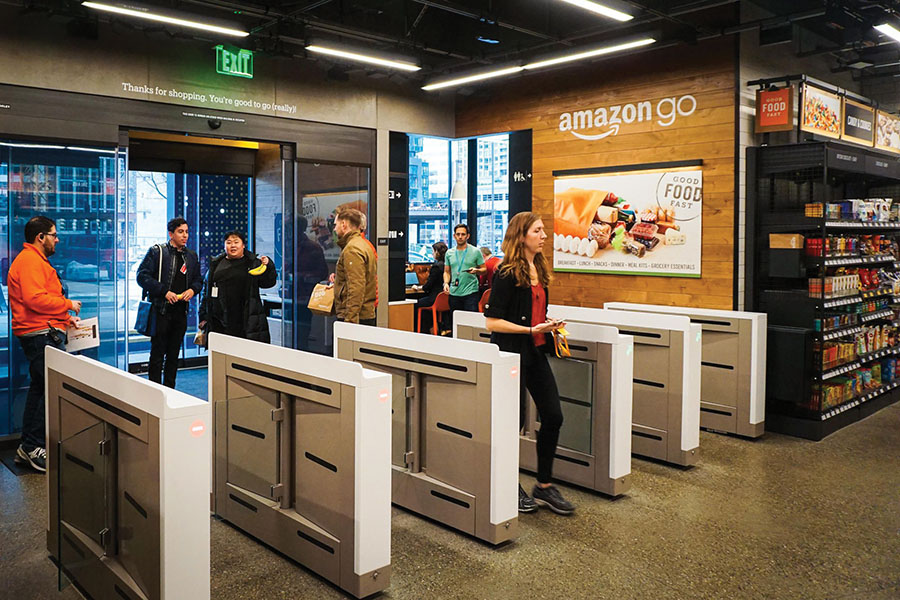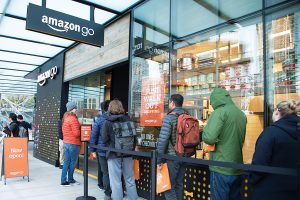Suppose the ‘retail experience’ was separated from the actual ‘purchase’. It happens now when you catch an Uber. You experience the service, but the purchase doesn’t take place at the end of the ride. Could you do that with everyday shopping? Well yes, of course you can – in fact, it’s already been done!
In light of the interest around America’s new Amazon Go store since its opening late last year, we at Hames Sharley have been discussing what this could mean for the future of the retail experience, the resulting design of retail and town centres.
- Amazon Go – a supermarket, without the checkout
In response to the rise of e-commerce, most retail developments have rightly focused on the creation of an experience, supplementing their core convenience and offering by reaching out to more of the catchment to create a place that drives social connectivity and interaction. Over the last five to 10 years Australian retail has had a renaissance, focusing more on the human spirit and the creation of desirable brands, experiences and products rather than sales, bargains and noise. So why has Amazon Go done the opposite?
Amazon Go is a physical store located in Seattle that opened to the public in January 2018. It can be understood as somewhat of a supermarket, without the checkout. The concept is made possible by technologies that detect your movement throughout the store, and when a physical product is added to your shopping cart, it translates to your virtual cart also. When you step outside the store, the technology is able to track what you have collected, and you are charged via your Amazon account as you cross both the real and virtual line of the tenancy. Essentially, payment occurs behind the scenes, or up in the ‘cloud’ – a transactional process that Amazon calls “just walk out shopping”.
One advantage of this is the eradication of queuing. Their grab-and-go system allows customers to save what is ultimately the most precious commodity in today’s society: time. It also gives you a surreal feeling akin to condoned shoplifting as you load up and simply walk out, as our team member Valentina Sansbury found out when visiting the store last January. “At first it was quite unnerving to pick up products and simply walk out. I must admit that I did glance over my shoulder once or twice to make sure that a security guard wasn’t following me!” she says.
However, its downfall could be the complete lack of human contact. There is not much person-to-person connection, but is the convenience store a place for that? Here, it revolves around the product. You can walk right through and grab what you need without making eye contact or talking to anyone. There’s not much experience in that. Besides not needing to wait for shipping, there isn’t much to set it apart from online shopping.
On their website, Amazon Go highlight the reason for building the store:
“Could we push the boundaries of computer vision and machine learning to create a store where customers could simply take what they want and go? Our answer to those questions is Amazon Go and Just Walk Out Shopping.”
Our main concern with this is that the invention is not driven by human behaviour, but rather by technology. It seems to be a sort of experiment to test how the experience would go. It’s not at all driven by the customer. And when the customer isn’t the driving factor of decision-making we enter into a risky space.
My prediction: I think Amazon Go will be a fad and stay within its realm of the convenience store. Yes, it represents a future but it isn’t the future.
There will be a future need by the consumer to have the greater convenience that this ‘just walk out’ technology provides. Equally there will be the need for immersive experiences in all categories. The consumer will have the choice to save time or use the necessity to experience something special and enrich everyday life.
For example, on one hand we have Amazon Go and on the other we have the Chapley – Foodland model. One extends the level of convenience and ease; the other creates an immersive experience at a world-class level. One serves an immediate catchment and the other reaches far beyond it, and perhaps one is fun to trial while the other may be more enduring.
- Chapley’s Foodland, Adelaide – an immersive experience at a world-class level
- Chapley’s Foodland, Adelaide – an immersive experience at a world-class level
- Chapley’s Foodland, Adelaide – an immersive experience at a world-class level
Sometimes, to see the future we must review the past. It could be argued that, in the 19th century, the birth of the shopping centre was spurred from the creation of the Burlington Arcade. Brought about by the invention of credit, women were now able to shop without being accompanied by their husbands, who at the time had control of the household funds. But walking along dirt and manure-ridden streets alone was considered distasteful, and an unfavourable experience for women to endure. This in turn led to the creation of an undercover arcade for women to walk through, known as the Burlington Arcade.
The simple introduction of credit created such a tangible transformation in the city landscape that it inspired the birth of the shopping centre and reinforced the need for sidewalks. Since then payment has moved towards tap-and-go (for example PayWave, PayPass and ApplePay) systems that lessen the need to hand over cash, which essentially saves customers time and effort. Now, Amazon Go has produced the ability for checkouts to be removed entirely, and I think there is a genius in that. There is potential for this technology to be implemented in retailers and shopping centres. I’m sure that the group of bankers that created the ability for credit had no idea at the time what ripples they would create to the built form of subsequent cities.
Many limitations from a design perspective have been driven around the need for security and staff minimisation. Shopfronts are both a control point to a point of sale and a line of security, as are the shop assistants, playing the dual role of concierge, ambassador and security (a complex balance).
Does this technology give us the opportunity to not be governed by these constraints? Does this herald a future of not requiring shopfronts, or at least a much higher level of permeability through and between shops, once demarcation between is virtually marked?
We would no longer be limited by a design that requires a checkout and security point at the store entrance. This means that we no longer need walls to separate stores. It changes the whole delineation of what makes a shop front. You don’t necessarily need physical markers to mark separate stores; instead, shopping from place to place can be made seamless, similar to that of a marketplace. At the market, people buy things from separate stallholders and travel seamlessly from stall to stall. There’s a special level of intimacy and social interaction that is achieved from this. Imagine if this concept could be replicated in the context of a shopping centre.
Something else that this automatic payment system allows for is the ability for staff to focus on the customer experience. Among other things, sales assistants take on the responsibilities of 1) helping the customer; 2) producing a transaction; and 3) monitoring theft. What if the last two could be taken away to focus on the first? Suddenly, staff are just there to help. Imagine how this could enhance human interaction. Only the positive remains in that personal interaction.
The seamlessness of the eradication of physical payment methods is quick, simple and also gives the customer a sense of freedom never before possible. Think about when you’re using Uber. The payment is dealt with behind the scenes and you’re able to enjoy the ride without the worry of handing over money at the end or risk missing your plane while your transaction is taking place in the back of a taxi. Or when you book a holiday in advance: you get on the flight and check into the hotel all without the stress of payment [that pain was overcome months before].
The ability for the ‘purchase’ to be carried out separately to the ‘experience’ rids the pain and stress of dealing with monetary transactions, allowing you to focus on the experience. And the result? The experience is more enjoyable.
All the interest around Amazon Go since its launch December 2016 has provided some food for thought, not so much on the experience that it provides, but the resulting payment system, and what this could mean for the future of retail design. While convenience-driven retail has its place, so too does the social and experiential interactions in a shopping centre. Technology should not be viewed as the competition, but rather, something that can be used to enhance customer experiences and create design opportunity. If it is used to better the customer experience, the Amazon Go ‘Just Walk Out’ payment method could just be the thing that generates a new level of seamless shopping interactions and unlocks another layer of preconceived design responses.

























